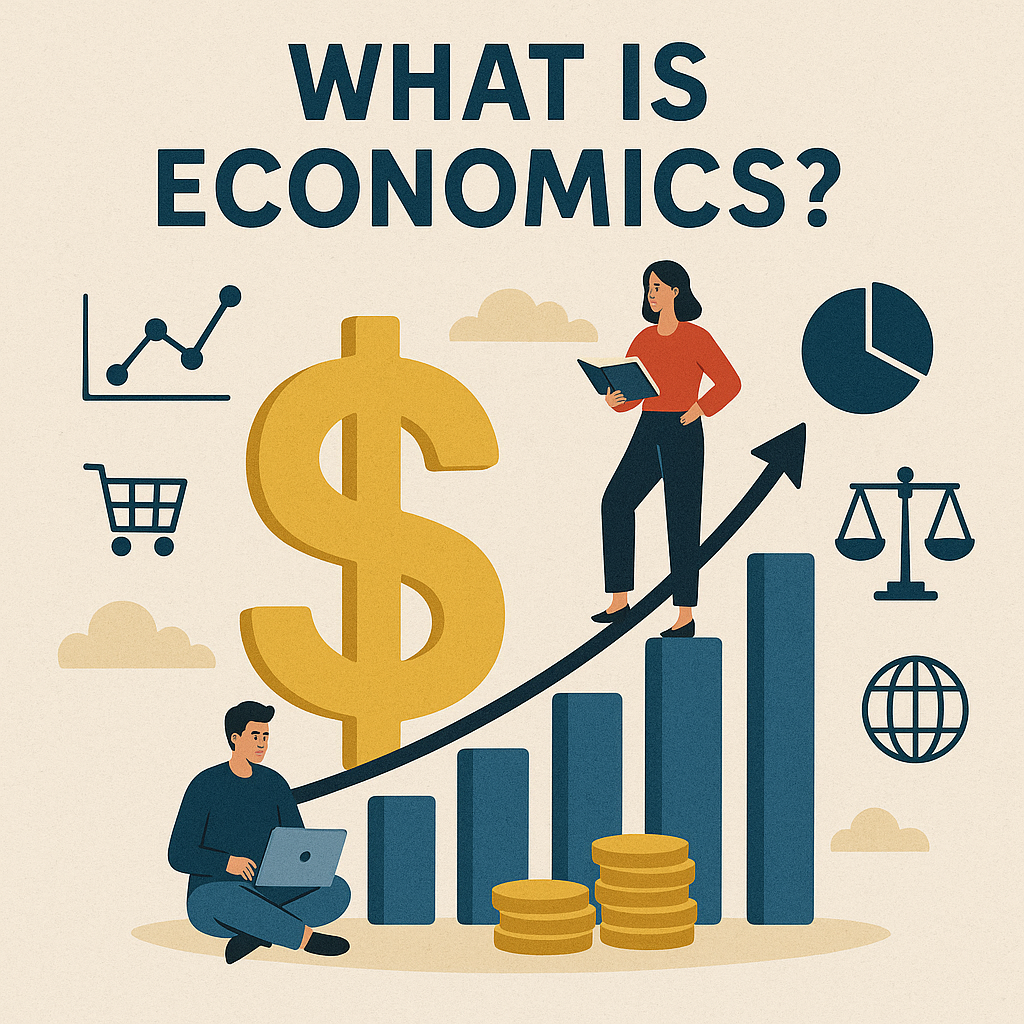What Is Economics?
Why Should We Learn About Global Markets?
Economics is the science that teaches us how to use limited resources. In other words, it is a branch of social science that analyzes the production, distribution, and consumption of goods and services. Overall, economics is the study of how to efficiently allocate limited resources to satisfy unlimited needs.
Two Main Perspectives in Economics
Microeconomics
Macroeconomics
Macroeconomics
Macroeconomics looks at the economy from a top-down perspective, focusing on issues like inflation, gross domestic product (GDP), and unemployment levels. Since this approach views things from above, the effects of economic changes are usually observed later and take time to impact markets.
Main Topics in Macroeconomics:
The big picture
National and international issues
Governments and economic policy
Microeconomics
Microeconomics looks at issues from within — like inside a company or a factory. Because it examines individual and internal factors, the effects of changes are observed more quickly.
Main Topics in Microeconomics:
Consumer decision-making and behavior at an individual level
Goods and services
Households and firms
Principles of Economics According to Gregory Mankiw
The cost of something is what you give up to get it (opportunity cost)
People are involved in trade (e.g., households)
People respond to incentives
Trade can make everyone better off (comparative advantage)
Markets are usually a good way to organize economic activity
Governments can sometimes improve economic outcomes
They intervene for fairness and better resource allocation
A country’s standard of living depends on its ability to produce goods and services
Too much money printing leads to inflation
Society faces a trade-off between inflation and unemployment
The Circular Flow of Income
This concept divides the economy into two major groups: households and firms.
Firms need labor, capital, and physical space to produce goods — which they acquire from households.
Households then consume the goods and services provided by firms.
Two Key Economic Terms:
Income: Net profit or income related to households
Revenue: Gross sales or income related to firms
Gross Domestic Product (GDP)
GDP is the total value of all final goods and services produced within a country — both by domestic and foreign resources — during a specific period (usually one year). It reflects a nation’s overall economic activity and performance and includes foreign workers.
Key Points About GDP:
GDP helps us understand how much money was spent on goods and services in a year.
Final goods are those purchased for end-use and not used in the production of other goods.
What Is Excluded from GDP?
Non-market activities (e.g., unpaid housework)
Black market/illegal activities
Used goods
Intermediate goods
Financial transfers (e.g., bonds, bank transfers)
Foreign production
Transfers like subsidies
Gross National Product (GNP)
GNP is the total value of goods and services produced by a country’s domestic resources, regardless of whether production occurs inside or outside the country. This includes citizens working abroad.
GDP Calculation Formula:
GDP = G + C + I + NX
Where:
G = Government Spending
C = Consumption
I = Investment
NX = Net Exports (Exports – Imports)
Important Equation:
Total Production = Total Income = Total Expenditure
Or:
GDP = Aggregate Demand = Aggregate Supply
Types of Investment
Fixed Investment: Equipment, buildings
Inventory Investment: Raw materials and goods
If demand falls, sales decrease → profits fall → investment declines → production drops → unemployment rises → purchasing power decreases → consumption falls.
Types of Consumer Goods
Durable Goods: TVs, cars
Non-durable Goods: Food, clothing
Types of Spending
Government Spending: Education, security, healthcare, infrastructure
Consumer Spending
Net Exports (Trade Balance)
Net Exports = Exports – Imports
A key component of GDP. The trade balance should ideally be positive for economic equilibrium.
Leakages vs. Injections in the Economy:
Leakages: Savings, Taxes, Imports
Injections: Investment, Government Spending, Exports
Equation: I + G + X = S + T + M
Factors Affecting Demand
Income (higher income → higher demand → higher prices)
Prices of other goods
Overall price level (inverse relationship)
Expectations
Tastes and preferences
Net exports
Monetary policy (interest rates)
Fiscal policy (taxation, government spending)
Types of Goods
Normal goods
Substitute goods
Complementary goods
Inferior goods
Three Main Macroeconomic Goals
Economic Growth & GDP
Low Unemployment
Price Stability (Inflation control)
Economic Growth – Pros & Cons
Pros:
Higher production
Better employment
Improved living standards
Cons:
Unequal income distribution
Resource depletion
Environmental pollution
Countries with the highest GDP: USA, Europe, China, Japan
What Is Unemployment?
An unemployed person is actively seeking a job but is unable to find one. Full employment, along with economic growth and price stability, is a key macroeconomic goal.
Unemployment Rate = (Number of Unemployed / Labor Force) × 100
Major Economic Recessions in the U.S.
The Great Depression (1930s)
The Great Recession (2008)
COVID-19 Recession (2020)
Types of Unemployment
Frictional: Time taken to switch jobs
Seasonal: Due to seasonal demand (e.g., agriculture)
Structural: Technological or regional causes
Cyclical: Related to business cycles (main cause of recessions)
Excluded from unemployment statistics:
Housewives
Retirees
Non-job seekers
Students
What Causes Currency Devaluation?
Global wars
Excessive money printing
Inflation
Currency Floating
Currencies used to be backed by gold. After global economic instability (post-WWII), in 1994, countries agreed to use the U.S. Dollar as a global standard, leading to currency floating and the rise of the Forex market.
Forex Market (Currency Pairs)
When the U.S. dollar became the global reference currency, currency exchange markets flourished. Understanding economics is vital to succeed in such markets.
The Saving Rule (20/30/50 Rule)
50%: Daily needs (food, shelter)
30%: Personal wants
20%: Savings
7 Core Economic Principles
Save at least 10% of your income
Control your expenses
Multiply your money through smart investments
Protect your assets (avoid risky investments)
Own your home and invest in real estate
Secure your future with insurance
Increase your skills and knowledge
Negative Inflation (Deflation)
Some countries experience deflation, which can:
Cause job losses
Drive out foreign labor
Lower prices of housing and oil
Causes of Deflation
Supply-side factors:
Contractionary monetary policy
Financial crises reducing bank lending
Demand-side factors:
Improved productivity
Decreased consumer spending
Bursting of asset bubbles
What Is an Economic Bubble?
A situation where prices rise rapidly without a basis in intrinsic value.
Four Stages of a Bubble:
Stealth Phase
Awareness Phase
Mania Phase
Blow-off Phase
Causes of Inflation
Monetary Causes:
Excess currency (cash, checks, accounts)
Cost-Push Causes:
Rising cost of raw materials
Higher wages
Energy price hikes
Supply chain disruptions



